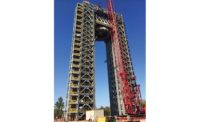Structural Test Stands at Marshall Space Flight Center
Huntsville, Ala.
Region ENR Southeast
Specialty Construction
Project Team
Owner U.S. Army Corps of Engineers-Mobile District
Lead Design Firm Goodwyn Mills and Cawood/Merrick & Co. Joint Venture
General Contractor Brasfield & Gorrie LLC
The National Aeronautics and Space Administration (NASA) describes the new Space Launch System—which will propel the agency’s Orion spacecraft to deep-space destinations—as being designed to be “flexible and evolvable” in order to accommodate varying sizes of rockets. For the contractors and engineers building the Space Launch System (SLS) Test Stands at Marshall Space Flight Center in Huntsville, Ala., remaining flexible while delivering what proved to be an evolving design goal became a core challenge.
“This project involved a tremendous amount of collaboration between the NASA testing engineers and our engineers and architects,” says Douglas Elledge, project manager with Merrick & Co. Merrick entered into a joint venture with Goodwyn Mills and Cawood as the project’s lead designer.
Known officially as Test Stands 4693 and 4697, the two structures function like “a giant piece of equipment” designed to test the SLS fuel tanks—which will measure up to 149 ft long—by simulating the pressures and stresses of launch and flight, says Elledge. Michael Tuggle, Brasfield & Gorrie’s senior project manager, says NASA will use the test stands to “twist, crush, stretch or whatever” the fuel tanks.
Essentially, the fuel tanks will be bolted into the structures and connected to hydraulic systems that will then exert tremendous forces upon the tanks to test how newly designed SLS components will perform under specific pressures.
As a result, both test stands required foundations with substantial amounts of reinforcing steel, anchoring components and mass placements of custom concrete pads. For the 221-ft tall Test Stand 4693—built upon the foundation of a test stand originally built for the Saturn V rocket—crews installed 415 tons of rebar and 420 tons of embedded steel frames. The test stand comprises two welded structural steel towers, connected at the top via large roof trusses that support a 1-million-lb movable crosshead frame. Platforms, located approximately every 10 ft for the full height of the test stand, provide access to the liquid hydrogen tank and allow for loads to be applied at virtually any elevation, according to information provided by Merrick.
The foundation for the shorter Test Stand 4697—just 97 ft tall—required 263 12-in.-dia concrete-filled pipe piles, 295 tons of rebar and 346 tons of embedded steel frames. Here, the project team was tasked to be “flexible” with an evolving design.
Due to the fact that NASA’s designs for the new rocket and its related testing program were still evolving during the course of the project, it was possible that changes to those designs could eventually impact the engineering of the test stands themselves.
Explains Tuggle: “Part of our challenge was that as one of those elements may change—the test program may want to test a different angle or direction, then [NASA] would have to reevaluate that—and typically that may change the structural element, and that may even translate down into the foundation.”
The mission for project engineers, says Elledge, was to come up with a design for the test stands that was “as flexible as possible so as to meet our current known needs, but also any future unknown needs. That was something that was kind of built into the project later in the design phase.”
“That’s a challenge,” Elledge continues. “There were a number of design changes during construction.”
And one of those involved Test Stand 4697, where NASA engineers asked the team about changing all of the structure’s steel connections.
Because the fabricator/erector had already ordered much of the structural steel, the team opted to address the issue partly by reinforcing the connections. For instance, Tuggle says, “A lot of the gusset plates got bigger, and we added steel.”
Another formidable challenge related to constructing the foundations, which required installing hundreds of 14-ft and 6-ft anchor rods on 18-in. centers, “all of which had to be precisely set to match the test stand structures,” Tuggle says.
Contractors used prefabrication to facilitate steel erection within the project site’s limited laydown area. Workers preassembled the test stand towers in seven tiers and stored them until they were ready to be set in place, for example. Similarly, crews assembled Test Stand 4693’s massive movable crosshead—including its 200-ton center-mounted positioning hoist, catwalks and handrails—on four temporary strand jacks, each with a 557-ton lifting capacity.
ENR’s Best of the Best judges made note of the project’s “great” safety record, which included a rate of zero for OSHA recordable incidents and lost-time accidents over the course of more than 243,000 worker-hours, according to the contractor.
Safety initiatives included controlled access, site-specific training and fully assessing work areas for unexploded ordinance left over from previous test programs. Tuggle says the “collaborative, overlapping safety oversight of the Corps, NASA and all contractors” paid off.
Overall, successfully delivering such complex, one-of-a-kind structures—while designs were still “evolving”—required the utmost attention to communication and collaboration, says the team.
“It was pretty much coordination meeting after coordination meeting,” says Tuggle. “It was just really a lot of coordination and planning with our team members.”
What NASA wanted was so different from anything the team had ever done, and so different “from what anyone else had ever done,” says Elledge. “This project involved a tremendous amount of collaboration—more than any project I can think of that Merrick has done in our history.”
Working under a contract with the U.S. Army Corps of Engineers, contractors completed the $68.8-million project in December 2016.
SLS will be the world’s most powerful rocket for human space exploration, including a planned trip to Mars. NASA has set December 2019 as the target date for its first launch of an SLS rocket.









Post a comment to this article
Report Abusive Comment